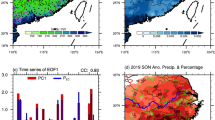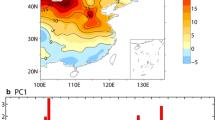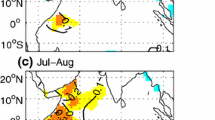Abstract
Observational and reanalysis data are used to investigate the different relationships between boreal spring sea surface temperature (SST) in the Indian and Pacific oceans and summer precipitation in China. Partial correlation analysis reveals that the effects of spring Indian Ocean SST (IO SST) and Pacific SST (PSST) anomalies on summer precipitation in China are qualitatively opposite. When IO SST anomalies are considered independently of PSST anomalies, precipitation decreases south of the Yangtze River, in most areas of Inner Mongolia, and in some parts of Liaoning Province, and increases in the Yangtze River valley, parts of southwestern and northern China, northeastern Inner Mongolia, and Heilongjiang Province. This results in a negative-positive-negative-positive pattern of precipitation anomalies in China from south to north. When PSST anomalies (particularly those in the Niño3.4 region) are considered independently of IO SST anomalies, the pattern of precipitation anomalies in China is positive-negative-positive-negative from south to north. The genesis of summer precipitation anomalies in China is also examined when El Niño-Southern Oscillation (ENSO) signals are removed from the ocean and atmosphere. An anticyclonic low-level wind anomaly forms in the South China Sea-Northwest Pacific area when the IO SST anomaly (SSTA) is warm and the Northwest Pacific SSTA is cold. This anticyclonic anomaly substantially influences summer precipitation in China. Anomalous warming of tropical IO SST induces positive geopotential height anomalies in the subtropics and an east-west dipole pattern in midlatitudes over Asia. These anomalies also affect summer precipitation in China.
Similar content being viewed by others
References
An, S. -I., 2003: Conditional maximum covariance analysis and its application to the tropical Indian Ocean SST and surface wind stress anomalies. J. Climate, 16, 2932–2938.
Ashok, K., S. K. Behera, S. A. Rao, et al., 2007: El Niño Modoki and its possible teleconnection. J. Geophys. Res., 112, C11007.
Baquero-Bernal, A., M. Latif, and S. Legutke, 2002: On dipole like variability of sea surface temperature in the tropical Indian Ocean. J. Climate, 15, 1358–1368.
Behera, S. K., S. Krishnan, and T. Yamagata, 1999: Unusual ocean-atmosphere conditions in the tropical Indian Ocean during 1994. Geophys. Res. Lett., 26, 3001–3004.
—, and T. Yamagata, 2003: Influence of the Indian Ocean dipole on the southern oscillation. J. Meteor. Soc. Japan, 81(1), 169–177.
Gao Hui, 2006: Decadal variation of the relationship between summer precipitation along the Huaihe River valley and SST over the equatorial eastern Pacific. J. Appl. Meteor. Sci., 17(1), 1–9. (in Chinese)
— and Wang Yongguang, 2007: On the weakening relationship between summer precipitation in China and ENSO. Acta Meteor. Sinica, 65(1), 131–137. (in Chinese)
Gill, A. E., 1980: Some simple solutions for heat-induced tropical circulation. Quart. J. Roy. Meteor. Soc., 106, 447–462.
Huang Ronghui and Wu Yifang, 1989: The influence of ENSO on the summer climate change in China and its mechanism. Adv. Atmos. Sci., 6, 21–32.
Jin Zuhui and Tao Shiyan, 1999: A study on the relationships between ENSO cycle and rainfalls during summer and winter in eastern China. Chinese J. Atmos. Sci., 23(6), 663–672. (in Chinese)
Kalnay, E., M. Kanamitsu, R. Kistler, et al., 1996: The NCEP/NCAR 40-year reanalysis project. Bull. Amer. Meteor. Soc., 77, 437–471.
Krishnamurthy, V., and B. P. Kirtman, 2003: Variability of the Indian Ocean: Relation to monsoon and ENSO. Quart. J. Roy. Meteor. Soc., 129, 1623–1646.
Kug, J. S., and I. S. Kang, 2006: Interactive feedback between ENSO and the Indian Ocean. J. Climate, 19, 1784–1801.
Lau, N. C., and M. J. Nath, 2000: Impact of ENSO on the variability of the Asian-Australian monsoons as simulated in GCM experiments. J. Climate, 13, 4287–4309.
Lin Hai, 2009: Global extratropical response to diabatic heating variability of the Asian summer monsoon. J. Atmos. Sci., 66, 2697–2713.
Long Zhenxia and Li Chongyin, 1999: Numerical simulation of the ENSO influences on East Asian monsoon activities afterwards. Acta Meteor. Sinica, 57(6), 651–661. (in Chinese)
Murtugudde, R., J. P. McCreary, and A. J. Busalacchi, 2000: Oceanic processes associated with anomalous events in the Indian Ocean with relevance to 1997–1998. J. Geophys. Res., 105, 3295–3306.
Saji, N. H., B. N. Goswami, P. N. Vinayachandran, et al., 1999: A dipole mode in the tropical Indian Ocean. Nature, 401, 360–363.
Smith, T. M., R. W. Reynolds, T. C. Peterson, et al., 2008: Improvements to NOAA’s historical merged land-ocean surface temperature analysis (1880–2006). J. Climate, 21, 2283–2296.
Wang, B., R. G. Wu, and T. Li, 2003: Atmospherewarm ocean interaction and its impacts on Asian-Australian monsoon variation. J. Climate, 16, 1195–1211.
Webster, P. J., V. O. Magaña, T. N. Palmer, et al., 1998: Monsoons: Processes, predictability, and the prospects for prediction. J. Geophys. Res., 103, 14451–14510.
—, A. M. Moore, J. P. Loschnigg, et al., 1999: Coupled ocean-atmosphere dynamics in the Indian Ocean during 1997–98. Nature, 401, 356–360.
Wu, B., T. J. Zhou, and T. Li, 2009: Seasonally evolving dominant interannual variability modes of East Asian climate. J. Climate, 22, 2992–3005.
—, T. Li, and T. J. Zhou, 2010: Relative contributions of the Indian Ocean and local SST anomalies to the maintenance of the western North Pacific anomalous anticyclone during the El Niño decaying summer. J. Climate, 23, 2974–2986.
Wu, R. G., Z. Z. Hu, and B. P. Kirtman, 2003: Evolution of ENSO-related rainfall anomalies in East Asia. J. Climate, 16, 3742–3758.
Wu Bingyi and Zhang Renhe, 2011: Interannual variability of the East Asian summer monsoon and its association with the anomalous atmospheric circulation over the mid-high latitudes and external forcing. Acta Meteor. Sinica, 69(2), 219–233. (in Chinese)
Xiao Ziniu, Yan Hongming, and Li Chongyin, 2002: Relationship between dipole oscillation of SSTA of Indian Ocean region and precipitation and temperature in China. J. Trop. Meteor., 8, 121–131.
Xie, S. P., H. Annamalai, F. A. Schott, et al., 2002: Structure and mechanisms of South Indian Ocean climate variability. J. Climate, 15, 864–878.
—, K. M. Hu, J. Hafner, et al., 2009: Indian Ocean capacitor effect on Indo-western Pacific climate during the summer following El Niño. J. Climate, 22, 730–747.
Xue, Y., T. M. Smith, and R. W. Reynolds, 2003: Interdecadal changes of 30-yr SST normals during 1871–2000. J. Climate, 16, 1601–1612.
Yamagata, T., S. K. Behera, S. A. Rao, et al., 2002: The Indian Ocean dipole: A physical entity. CLIVAR Exch., 24(7), 2.
Yang Jianling, Liu Qinyu, and Liu Zhengyu, 2010: Linking observations of the Asian monsoon to the Indian Ocean SST: Possible roles of Indian Ocean basin mode and dipole mode. J. Climate, 23, 5889–5902.
Yoo, S. H., S. Yang, and C. H. Ho, 2006: Variability of the Indian Ocean sea surface temperature and its impacts on Asian-Australian monsoon climate. J. Geophys. Res., 111, D03108.
—, J. Fasullo, S. Yang, et al., 2010: On the relationship between Indian Ocean sea surface temperature and the transition from El Niño to La Niña. J. Geophys. Res., 115, D15114.
Yu, J. Y., S. P. Weng, and J. D. Farrara, 2003: Ocean roles in the TBO transitions of the Indian-Australian monsoon system. J. Climate, 16, 3072–3080.
—, and K. M. Lau, 2005: Contrasting Indian Ocean SST variability with and without ENSO influence: A coupled atmosphere-ocean GCM study. Meteor. Atmos. Phys., 90, 179–191.
Yu Zhihao and Jiang Quanrong, 1994: El Niño, Anti-El Niño, and Southern Oscillation. Nanjing University Press, Nanjing. 427 pp. (in Chinese)
Zhang, L., P. Chang, and M. K. Tippett, 2009: Linking the Pacific meridional mode to ENSO: Utilization of a noise filter. J. Climate, 22, 905–922.
Zhang, R. H., A. Sumi, and M. Kimoto., 1996: Impact of El Niño on the East Asian monsoon: A diagnostic study of the 86/87 and 91/92 events. J. Meteor. Soc. Japan, 74, 49–62.
—, —, and —, 1999: A diagnostic study of the impact of El Niño on precipitation in China. Adv. Atmos. Sci., 16, 229–241.
—, and —, 2002: Moisture circulation over East Asia during El Niño episode in northern winter, spring and autumn. J. Meteor. Soc. Japan, 80, 213–227.
Zhang Qin and Yang Song, 2007: Seasonal phase-locking of peak events in the eastern Indian ocean. Adv. Atmos. Sci., 24, 781–798.
Zhang Renhe, Wu Bingyi, Zhao Ping, et al., 2008: The decadal shift of the summer climate in the late 1980s over eastern China and its possible causes. Acta Meteor. Sinica, 22(4), 435–445.
Zhou, T. J., R. C. Yu, H. M. Li, et al., 2008: Ocean forcing to changes in global monsoon precipitation over the recent half-century. J. Climate, 21, 3833–3852.
—, —, J. Zhang, et al., 2009: Why the western Pacific subtropical high has extended westward since the late 1970s. J. Climate, 22, 2199–2215.
Zhu, Y. L., and D. D. Houghton, 1996: The impact of Indian Ocean SST on the large-scale Asian summer monsoon and the hydrological cycle. Int. J. Climatol., 16, 617–632.
Author information
Authors and Affiliations
Corresponding author
Additional information
Supported by the National Natural Science Foundation of China (40875052, 40921003, and 41175082) and China Meteorological Administration Special Public Welfare Research Fund (GYHY200906017 and GYHY200706005).
Rights and permissions
About this article
Cite this article
Li, Y., Wu, B., Yang, Q. et al. Different relationships between spring SST in the Indian and pacific oceans and summer precipitation in China. Acta Meteorol Sin 27, 509–520 (2013). https://doi.org/10.1007/s13351-013-0501-4
Received:
Accepted:
Published:
Issue Date:
DOI: https://doi.org/10.1007/s13351-013-0501-4




